#c: armenian
Explore tagged Tumblr posts
Text

Folio 9 verso, Bodl. MS. Arm. d. 25
#manuscript#illuminated manuscript#gospel book#y: 1500s#c: armenian#l: classical armenian#t: page#Bodl. MS. Arm. d. 25
113 notes
·
View notes
Text
i think the other frustrating thing is like. people online forget that politics and war is complicated. it sucks, it's tedious. civilians are being hurt and killed as a result of fascism and greed. this isnt a saturday morning cartoon. you can't always be spoon-fed tl;drs on who's the good guy and who's the villain. this shit is fluid, and often just looks like this:
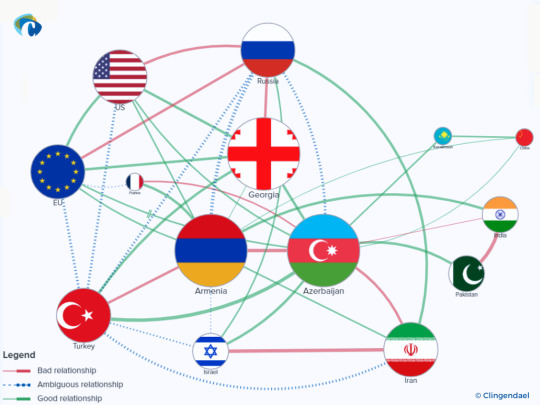
#like. ex: ukraine is actually an azeri ally. they're buddies.#but even as a diasporan armenian watching her country get attacked by azerbaijan i dont support russia attacking ukraine#and even now. despite ukraine having been an azeri ally. azeris are driving in the streets celebrating russia for helping armenia back down#like. this is shit is messy. it has layers.#my friends were talking about how armenia and india want to work together more. and my friend (who's indian!) was concerned#b/c while she supports armenia - india's current govt is fascist and we collectively. obviously. dont support that.#like!! none! of this! is clear-cut!!!#meanwhile my other armenian friend and i were like absolutely. like muslims in india are fighting to survive.#and armenians are also afraid of suffering through a 2nd genocide#what choice do we have if we have to buy arms from india#when no country will sanction aze or intervene in a substantial way#we've had 3 years of politicians saying 'someone should do something!!' and then crickets.#what would you do?#xangoeswah
36 notes
·
View notes
Text

Was sitting down to write in my journal and looked at all the stuff on the table, and it was all beautiful to me so I arranged it a bit. I've been broke pretty much my entire life and I'm deeply irresponsible with money—I can't pretend that material stuff makes a person happy—but looking at the table and seeing all these little things I've collected over the years, I'm pleased.
I enjoy the evidence of my interests, the souvenirs of a silly life. A hobo lighter next to french incense papers next to a japanese journal next to gamer glasses next to a vitamin + medication organizer from amazon next to earbuds with a case that feels like a smooth rock from a river shore next to a gudetama fountain pen resting on top of an open-box clearance chromebook from best buy.
Most days all this stuff is just a bunch of crap I wouldn't care about leaving behind or losing—but sometimes I look at these things and see a map, I look at it all and get curious about where to go next.
#aesthetic#a e s t h e t i c#personal#stuff#writerblr#journal#fragrance#fountain pen#incense#collection#things#oh no I see tiktok found out about armenian papers I hope they don't become really hard to find now
4 notes
·
View notes
Text
The French Connection
Music in France around the end of the 19th Century and beginning of the 20th Century is often defined by the music of Debussy and Ravel. However, there were other composers at that time who, stylistically, were heading in another direction. Phil Whelan and I take a look at some of these composers and, unsurprisingly, find some glorious music. Georges Bizet (1838-1875)Symphony in C: Movt IV…
#Academy of St Martin-in-the-Fields#Anne Sofie von Otter#Bailero#Bengt Forsberg#Bomsori#Canadian Chamber Orchestra#Cécile Chaminade#Georges Bizet#Giancarlo Guerrero#Hector Berlioz#Joseph Canteloube#Jules Massenet#Karina Gauvin#London Symphony Orchestra#NFM Wrocław Philharmonic Orchestra#Overture: The Roman Carnival Op 9#Raffi Armenian#Sir Colin Davis#Sir Neville Mariner#Songs of the Auvergne#Symphony in C#Thaïs: Meditation#When your sky turns golden in the morning lights
0 notes
Text
okay music question (feel free to still answer if you don't do all 3 of these): what style of music do you listen to most + what style do you enjoy seeing live + what style do you prefer to play, and are they all different or do they overlap?
#bc i realised. on bass i most enjoy playing stuff with like grooves. like funk and disco and stuff#and also dub and reggae and stuff like that#i guess genres where bass is a big part of it#but then i don't really listen to those styles of music much#i listen to a lot of dream pop shoegaze indie power pop jangle pop twee pop etc#but i have no interest in playing it. maybe if i was a guitarist I'd play it more. and also seeing it live idk. maybe#whereas folk/traditional music live is UNMATCHED. the other day i went to this armenian folk gig and it was unreal#and I went to loads of irish folk sort of gigs when i was really into that c. 2017/18#like literally any traditional music from any country i will lose my mind seeing it live. and tbf it's stuff i listen to but not as much as#i did when i was 17/18. and i never play it mainly bc i don't really play any relevant instruments fluently enough#soooooo. i listen to jangly dreamy stuff. i play funky groovy stuff. and i go to folky/traditional live stuff.#and like. does anyone else have this or do you listen to/watch live/play similar stuff. or does it depend etc#also feel free to answer even if you don't do all three things. i'm unwell about analysing people's music tastes so i'll be happy with any#answer. but yeah#ramble
1 note
·
View note
Text
Armenia according to anon


#they take away your armenian card if you have sex actually#c#btw I think BTS’s greatest gift has been this gif and I finally get the chance to use it
5K notes
·
View notes
Text


Armenian pictorial rugs, early 20th c.
840 notes
·
View notes
Text




In the synagogue of Isfahan, Iran, 2011. By Kaveh Kazemi.
The origin of the Jewish community in Isfahan has been ascribed by Pehlevi, Armenian, and Islamic sources to various early historical periods beginning in 470 C. E. Under the caliphate, the Jewish quarter of Isfahan, known as Jayy, had grown to such a degree in number and size that geographers called it al-Yahudiyya, "the city of the Jews." Here, Jewish poets, musicians, rabbis and scholars flourished for many centuries.
409 notes
·
View notes
Text

For those who are confused about the situation in Artsakh (part 1)
To anyone even remotely knowledgeable about the history of the region, the azerbaijani claims that Artsakh belongs or belonged to them, or that they are the natives of the land, sound not only incorrect but also hilariously pathetic. The earliest evidence of Artsakh’s ancient history dates back to the earliest stages of the Stone Age, specifically the Acheulean and subsequent periods (800,000 to 100,000 years ago). These include stone and bone tools found in the caves of Orvan-Msoz, Tsatsakhach, and Khoradzor. Excavations of settlements and tombs from the Bronze and Iron Ages (Stepanakert, Khojaly, Karkarjan, Amaras, Madagis, and the valleys of the Khachenaget and Ishkhanaget rivers) indicate that this area was part of the Kur-Araxes cultural system formed in the 4th-3rd millennia BC. The Kur and Arax are rivers in the Armenian Highlands; Arax is even considered the “mother river” of Armenia and is referred to as “Mother” in many Armenian poems and songs.
Artsakh was the northeastern boundary of the region where the Armenian people formed ethnically. This has been mentioned many times in the works of Strabo (64 or 63 BC – c. 24 AD, a Greek geographer, philosopher, and historian), Ptolemy (c. 100 - c. 170 AD, a renowned Greek geographer, astronomer, and mathematician), and many other non-Armenian geographers and historians. For over 3000 years, Artsakh has been inhabited by its natives, the Armenians.
You might ask, what do these historians write about the azerbaijanis? Well, nothing—because azeris did not exist back then and wouldn’t exist for at least the next 3000 years. How, then, could they have been the natives of the land?
Furthermore, aren’t azeris Muslim? In that case, how is it that right after Armenia adopted Christianity as its official religion—being the first nation to do so—many churches were built in Artsakh, not mosques, but churches? For example:
Gandzasar Monastery (4th century) and St. John the Baptist Church (1216-1238)
Dadivank (4th century) and Katoghike (9th-11th century)
Amaras Monastery (4th century)
St. George Church of Tzitzernavank (4th-5th century)
Gtichavank (4th-13th century)
Monastery of Apostle Yeghishe (Jrvtshtik) (5th century), Mataghis
Vankasar White Cross (5th century)
Kataro Monastery of Dizapayt and Holy Mother of God (5th century)
Mokhrenis Okht Drne Monastery (7th-17th century)
Kolatak St. Hakob Monastery (9th century)
Tsori Holy Savior (9th century)
Tsamakahogh St. Stephen (9th-10th century)
White Cross Monastery of Vank village, Hadrut (10th century)
Desert Monastery of Elisha Kusi, Chartar (12th century)
St. George Church of Jankatagh (12th century)
Khotavank (12th-13th century)
Holy Mother of God Nuns' Monastery of Karvachar (12th-13th century)
St. Savior Church of Poghosagomer (12th-13th century)
Shoshkavank Holy Mother of God of Msmena (13th century)
Horeka Monastery (13th century)
Kavakavank (14th century)
And many, many more. It pains me to tears to say that these churches, along with hundreds of others, are being destroyed by azeris to wipe out the evidence that Armenians lived there, pushing their false narrative that they are the natives of the land. Since the 2020 war, azerbaijani forces have destroyed over 570 Armenian cultural sites, with 3 to 4 monuments being demolished weekly—not to mention the desecration of both old and new Armenian graves.
So, the next time an azeri tries to argue that they are the natives of Artsakh and Armenia, just laugh at their faces. I’m sure I’ve got socks in the back of my drawer that are older than their “nation.”
#break the chain of ignorance#feel free to fact check what you read#history#artsakh is armenia#artsakh#armenia#world politics#world history#azeri crimes#turkish crimes#stop the genocide#armenian culture
197 notes
·
View notes
Text
This reminds me of the issues in transliterating Armenian, where the aspirated stop series is (traditionally) transliterated using a turned comma, meant to emulate the Greek spiritus asper. The actual signs used are many, however:
⟨ ʻ ⟩ = U+02BB : MODIFIER LETTER TURNED COMMA
⟨ ‘ ⟩ = U+2018 : LEFT SINGLE QUOTATION MARK
⟨ ʿ ⟩ = U+02BF : MODIFIER LETTER LEFT HALF RING
⟨ ʽ ⟩ = U+02BD : MODIFIER LETTER REVERSED COMMA
⟨ ῾ ⟩ = U+1FFE : GREEK DASIA (the actual spiritus asper used in the Greek alphabet)
⟨ ՙ ⟩ = U+0559 : ARMENIAN MODIFIER LETTER LEFT HALF RING (used in Armenian dialectology in the Armenian alphabet, copying the use in the romanization of the alphabet)
and then the two that don't really try:
⟨ ’ ⟩ = U+0027 : APOSTROPHE (used in the ASCII romanization)
⟨ ’ ⟩ = U+2019 : RIGHT SINGLE QUOTATION MARK (used in the ALA-Library of Congress romanization)
Some authors also use superscripted letter C or c (not sure if those are superscripted regular letters or actual Unicode ⟨ ᶜ ⟩ = U+1D9C : MODIFIER LETTER SMALL C, not that it matters much):


— short excerpts from Matasović's A Grammatical Sketch of Classical Armenian (2009) and Olsen's The Noun in Biblical Armenian (1999)
cf. more normal ones in Lexikon der indogermanischen Verben (2001) and Martirosyan's Etymological Dictionary of the Armenian Inherited Lexicon:


though I'm still not entirely sure what sign LIV is using (the half-ring?)
ever since I learned about the “turned comma,” the rotated comma type that typographers once used as a superscript “c,” Michael G. Collins, M‘Culloch and the Turned Comma, 12 Green Bag 2d 265 (2009), I can’t help but notice when people get it wrong
Justice Kagan, for example, got it wrong in Kahler v. Kansas, No. 18-6135, slip op. at 2 (U.S. March 23, 2020):


but it’s actually M‘Naghten’s Case (1843) 10 Cl. & Fin. 200, 8 Eng. Rep. 718 (HL), as the report reveals:

word processors can’t rotate type, but we could approximate the “turned comma” much better if we used a single open quotation mark (‘) instead of an apostrophe (’), as Justice Kagan does here
or we could just use “c,” as we do for McCulloch v. Maryland, 17 U.S. (4 Wheat.) 316 (1819), even though the report reads:

#j#lang#sorry to go off topic#it's just funny to me how armenian trnasliteration has the opposite problem of ppl using actual C for a turned-comma-like diacritic
29 notes
·
View notes
Text
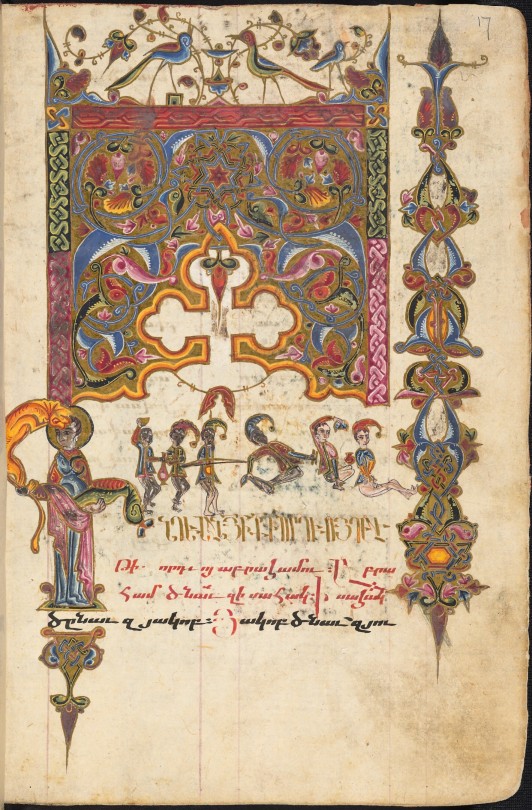
Folio 17 recto, Bodl. MS. Arm. d. 25
#manuscript#illuminated manuscript#gospel book#y: 1500s#c: armenian#l: classical armenian#t: page#Bodl. MS. Arm. d. 25
41 notes
·
View notes
Text


#i never applied for a citi card but can i get a cut of that cash actually 🙋♀️🙋♀️🙋♀️🙋♀️#ironically i dont have i/yan b/c my dads not armenian (assyrian king lets go) but lmao#xangoeswah
8 notes
·
View notes
Photo

The Mithridate Wine, c. 2009. Rubik Kocharian (Armenian, 1940-2019) 16" x 20", oil on linen,
#The Mithridate Wine#Art#Artedit#Rubik Kocharian#Armenian artist#Still life#Fruit#Food#Pomegranate series
1K notes
·
View notes
Photo

Tigranes the Great
Tigranes II or Tigranes the Great ruled as the king of Armenia from c. 95 to c. 56 BCE. Expanding in all directions, at its peak, Tigranes' Armenian Empire stretched from the Black Sea to the Mediterranean. Not before or since would Armenians control such a huge swathe of Asia. Tigranes would only be checked once his kingdom became enmeshed in the ambitions of the two regional superpowers, Parthia and Rome, when his alliance with Mithridates VI, king of Pontus, proved his undoing.
The Artaxiad Dynasty
The Artaxiad (Artashesian) dynasty had replaced the Orontid dynasty and ruled ancient Armenia from c. 200 BCE to the first decade of the 1st century CE. Founded by Artaxias I (r. c. 200 - c. 160 BCE), the dynasty would ensure Armenia enjoyed a sustained period of prosperity and regional importance and no one would contribute more than their greatest king Tigranes II, widely considered the most important and successful ruler in Armenia's entire history.
Continue reading...
57 notes
·
View notes
Note
Hi! What do you mean when you say assyrian? Like what is your cultural heritage like? What facets of historical assyria do you currently imbibe/try to emulate? I'm a bit of a history nerd and saw your rice post, so i thought i'd try and get some first person perspectives on this for a pet project of mine. (Anoning coz my main is a hornyblog)
hi, anon! assyrians are not just a historical empire- we are a contemporary ethnic group!
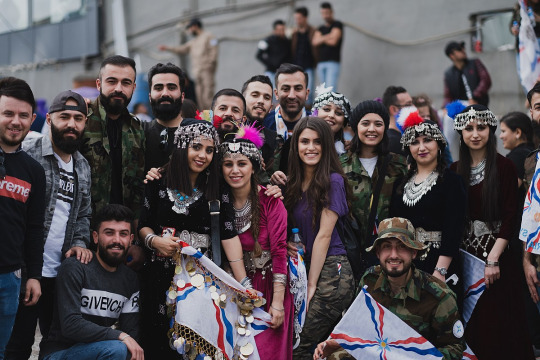
the assyrians are indigenous to the mesopotamian area, and are descended from the original assyrians with whom you are likely more familiar. however, the the assyrian genocide or sayfo that began in 1915 (connected to the armenian genocide + the greek genocide) caused many people to flee to other countries, including my mom's family, so there are more assyrians in the diaspora than in the "homeland" these days.
you may also see us referred to as syriac (with a C, not syrian), which some people prefer because it is a clearer differentiation between ancient assyrians and modern assyrians/syriacs. there are a few other terms like nestorian, aramean, chaldean, but not all of those are in common use these days either and mostly have specific use cases when it comes to language or religion (ex. nestorian mostly refers to members of the assyrian church of the east, but in some older texts it's used to describe assyrians regardless of specific church affiliation). generally people just identify as assyrian.
we did descend from ancient assyrians, and modern assyrian languages (suret) did come from old aramaic, but for me that connection has a pretty negligible connection to modern life, aside from occasionally pointing at assyrian statues in museums and saying "lol look it's us" to my brother. not sure if that's the case for other assyrians, but it isn't something i've seen personally.
if you've got an interest in history, however, you may enjoy our flag!
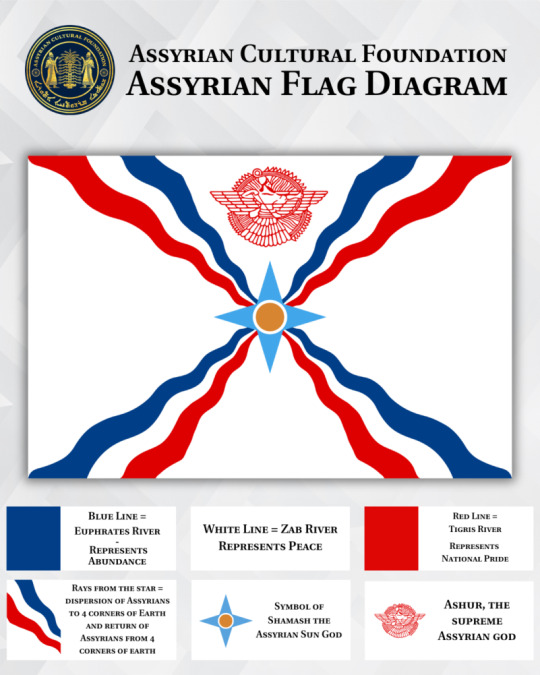
i swear i'm not mad that i spent ten minutes writing out my own description only to find that the ACF already had this nice helpful diagram my only addition is that the gold part of the symbol in the center represents the sun and the four-pointed star represents land, with the light blue representing tranquility. also that i could have SWORN there was something representing martyrs but apparently not lol. the one assyrian cultural artefact that doesn't reference martyrs i guess.
you can also find variants of this flag with the ashur emblem either outlined in gold or colored in with gold and blue, but afaik there's not a significant symbolic difference there
this flag was designed by george bit atanus as part of a competition started by the assyrian universal alliance in 1968, and adopted some time in the early 70s. i should note that the presence of ashur and shamash on this flag are more of a tribute to ancient assyrians as part of our history as opposed to a current religious reference, as assyrians are overwhelmingly christian.
i ended up writing a lot more for this than i thought i would and now i don't know how to end this post lol. uhh take this screenshot from the "assyrian people" wiki page that always makes me laugh a little bit
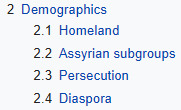
like yes we have been persecuted enough for it to be a whole section on our wiki page ✨ #flex #winning
108 notes
·
View notes
Text
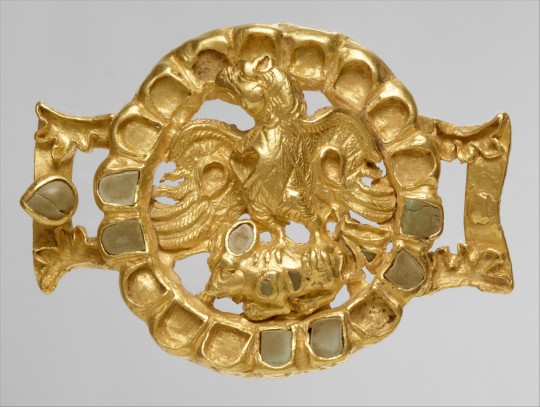
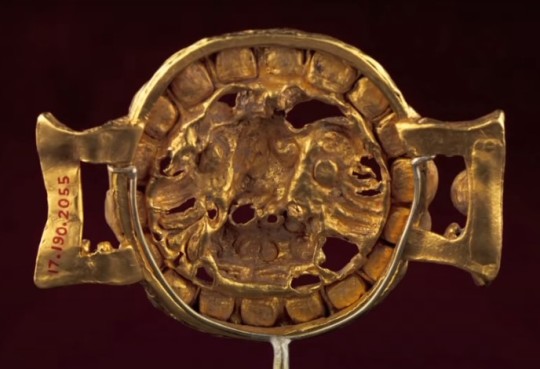
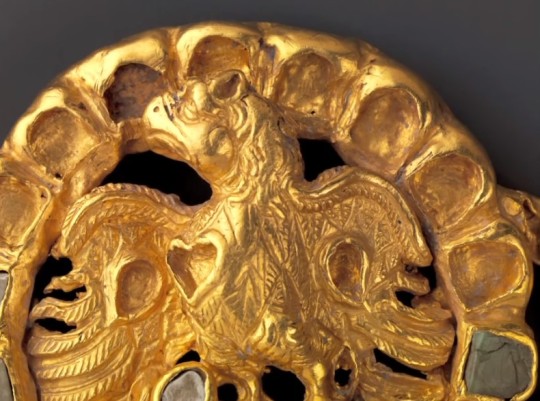
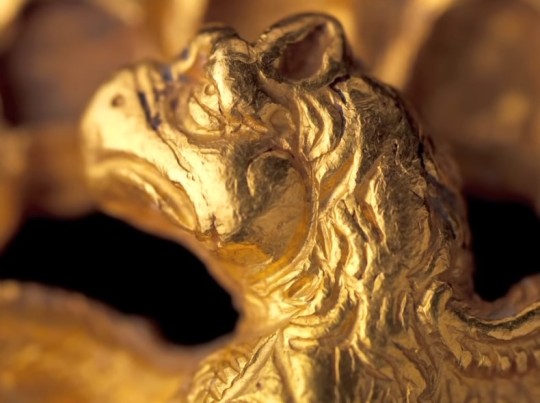
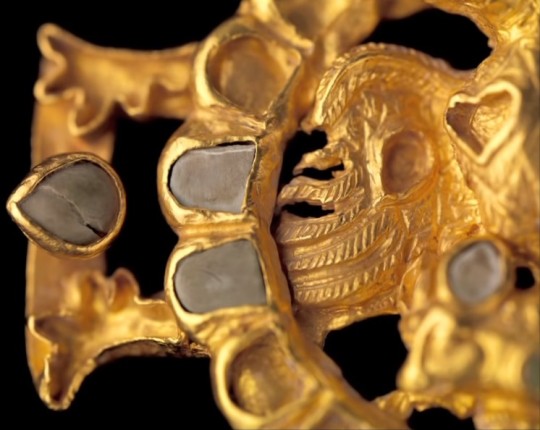

Gold clasp of eagle, possibly belonging to the House of Karen, 1st-2nd C. CE. Found in Nahavand. The House of Karen seems to have been descended from the Parni, who were themselves an offshoot of the Scythians. Ernst Herzfeld wrote that this item probably belonged to their house.
"House of Karen (Middle Persian: Kārēn; Parthian: 𐭊𐭓𐭍𐭉, romanized: Kārēn; Persian: کارن, romanized: Kārin or Kāren), also known as Karen-Pahlav (Kārēn-Pahlaw) was one of the Seven Great Houses of Iran during the rule of Parthian and Sassanian Empires. The seat of the dynasty was at Nahavand, about 65 km south of Ecbatana (present-day Hamadan, Iran). Members of House of Karen were of notable rank in the administrative structure of the Sassanian empire in multiple periods of its four century-long history.
The Karens, Karan-Vands, Qarinvand dynasty or Karen-Pahlevi as they are also called, claimed descent from Karen, a figure of folklore and son of the equally mythical Kaveh the Blacksmith. Their historical origin however may be that the Karens, along with the House of Mihran, were descended from the Arsacids. According to Movses Khorenatsi, this descent was via one of the three sons of Phraates IV, also named Karen. The fact that Karen may also have been among the family names of the Arsacid dynasty may give credence to this theory.
The first verified reference to the Karenas was during the Arsacid era, specifically as one of the feudal houses affiliated with the Parthian court. In this they were similar to the House of Suren, the only other attested feudal house of the Parthian period. Following the conquest of the Parthians, the Karenas allied themselves with the Sassanids, at whose court they were identified as one of the so-called "Parthian clans". The Armenian Kamsarakan family was a branch of the House of Karen."
-taken from Wikipedia
youtube
#scythian#iranian#ancient persia#ancient history#history#art#antiquities#museums#archaeology#heart symbol#Youtube
208 notes
·
View notes